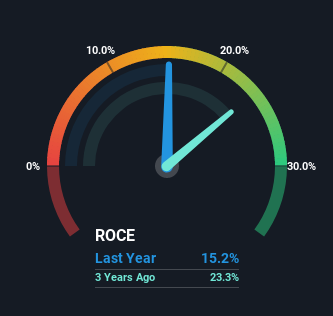- United States
- /
- Food
- /
- NasdaqGS:MZTI
Returns On Capital Signal Tricky Times Ahead For Lancaster Colony (NASDAQ:LANC)
What are the early trends we should look for to identify a stock that could multiply in value over the long term? Firstly, we'd want to identify a growing return on capital employed (ROCE) and then alongside that, an ever-increasing base of capital employed. Ultimately, this demonstrates that it's a business that is reinvesting profits at increasing rates of return. However, after briefly looking over the numbers, we don't think Lancaster Colony (NASDAQ:LANC) has the makings of a multi-bagger going forward, but let's have a look at why that may be.
What Is Return On Capital Employed (ROCE)?
If you haven't worked with ROCE before, it measures the 'return' (pre-tax profit) a company generates from capital employed in its business. Analysts use this formula to calculate it for Lancaster Colony:
Return on Capital Employed = Earnings Before Interest and Tax (EBIT) ÷ (Total Assets - Current Liabilities)
0.15 = US$140m ÷ (US$1.1b - US$179m) (Based on the trailing twelve months to March 2022).
Therefore, Lancaster Colony has an ROCE of 15%. On its own, that's a standard return, however it's much better than the 10.0% generated by the Food industry.
See our latest analysis for Lancaster Colony

Above you can see how the current ROCE for Lancaster Colony compares to its prior returns on capital, but there's only so much you can tell from the past. If you'd like, you can check out the forecasts from the analysts covering Lancaster Colony here for free.
The Trend Of ROCE
When we looked at the ROCE trend at Lancaster Colony, we didn't gain much confidence. Over the last five years, returns on capital have decreased to 15% from 32% five years ago. Although, given both revenue and the amount of assets employed in the business have increased, it could suggest the company is investing in growth, and the extra capital has led to a short-term reduction in ROCE. And if the increased capital generates additional returns, the business, and thus shareholders, will benefit in the long run.
The Bottom Line On Lancaster Colony's ROCE
In summary, despite lower returns in the short term, we're encouraged to see that Lancaster Colony is reinvesting for growth and has higher sales as a result. These trends are starting to be recognized by investors since the stock has delivered a 37% gain to shareholders who've held over the last five years. Therefore we'd recommend looking further into this stock to confirm if it has the makings of a good investment.
Lancaster Colony does have some risks, we noticed 2 warning signs (and 1 which shouldn't be ignored) we think you should know about.
For those who like to invest in solid companies, check out this free list of companies with solid balance sheets and high returns on equity.
New: Manage All Your Stock Portfolios in One Place
We've created the ultimate portfolio companion for stock investors, and it's free.
• Connect an unlimited number of Portfolios and see your total in one currency
• Be alerted to new Warning Signs or Risks via email or mobile
• Track the Fair Value of your stocks
Have feedback on this article? Concerned about the content? Get in touch with us directly. Alternatively, email editorial-team (at) simplywallst.com.
This article by Simply Wall St is general in nature. We provide commentary based on historical data and analyst forecasts only using an unbiased methodology and our articles are not intended to be financial advice. It does not constitute a recommendation to buy or sell any stock, and does not take account of your objectives, or your financial situation. We aim to bring you long-term focused analysis driven by fundamental data. Note that our analysis may not factor in the latest price-sensitive company announcements or qualitative material. Simply Wall St has no position in any stocks mentioned.
About NasdaqGS:MZTI
Marzetti
Engages in manufacturing and marketing of specialty food products for the retail and foodservice channels in the United States.
Flawless balance sheet with solid track record and pays a dividend.
Similar Companies
Market Insights
Community Narratives



